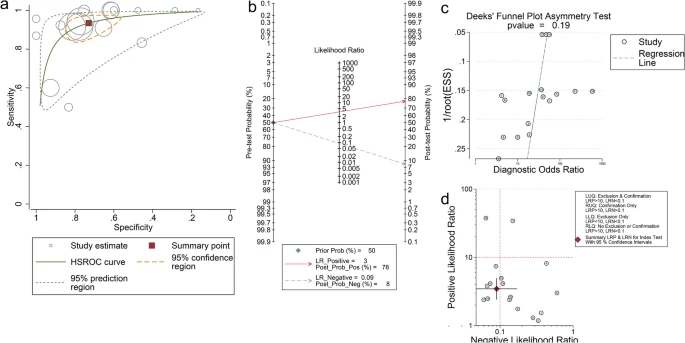BMC Pulmonary Medicine 23, Article number: 374 (2023)
Abstract
Background
Hitherto, the bulk of diagnostic criteria regards Aspergillus-specific immunoglobulin E as a key item, and regard IgG as an auxiliary method in diagnose. Nevertheless, there is no conclusive study in summarize the performance of IgG and IgE diagnosing ABPA.
Methods
We conducted a systematic review to identify studies report results of IgE and IgG detection in diagnosing ABPA. QUADAS-2 tool was used to evaluate included studies, and we applied the HSROC model to calculate the pooled sensitivity and specificity.
Deeks’ funnel was derived to evaluated the public bias of included studies, and Cochrane Q test and I2 statistic were used to test the heterogeneity.Results
Eleven studies were included in this study (1127 subjects and 215 for IgE and IgG). Deeks’s test for IgE and IgG were 0.10 and 0.19. The pooled sensitivity and specificity for IgE were 0.83 (95%CI: 0.77, 0.90) and 0.89 (0.83, 0.94), and for IgG were 0.93 (0.87, 0.97) and 0.73 (0.62,0.82), with P value < 0.001. The PLR and NLR for IgE were 7.80 (5.03,12.10) and 0.19 (0.13,0.27), while for IgG were 3.45 (2.40,4.96) and 0.09 (0.05,0.17). The combined diagnostic odds ratio and diagnostic score were 41.49 (26.74,64.36) and3.73 (3.29,4.16) for IgE, respectively, and were 38.42 (19.23,76.79) and 3.65 (2.96,4.34) for IgG.
Conclusion
The sensitivity for IgG diagnosing ABPA is higher than IgE, while the specificity for IgE is higher. IgG might be able to play a more important role in filtering ABPA patients.


No comments:
Post a Comment